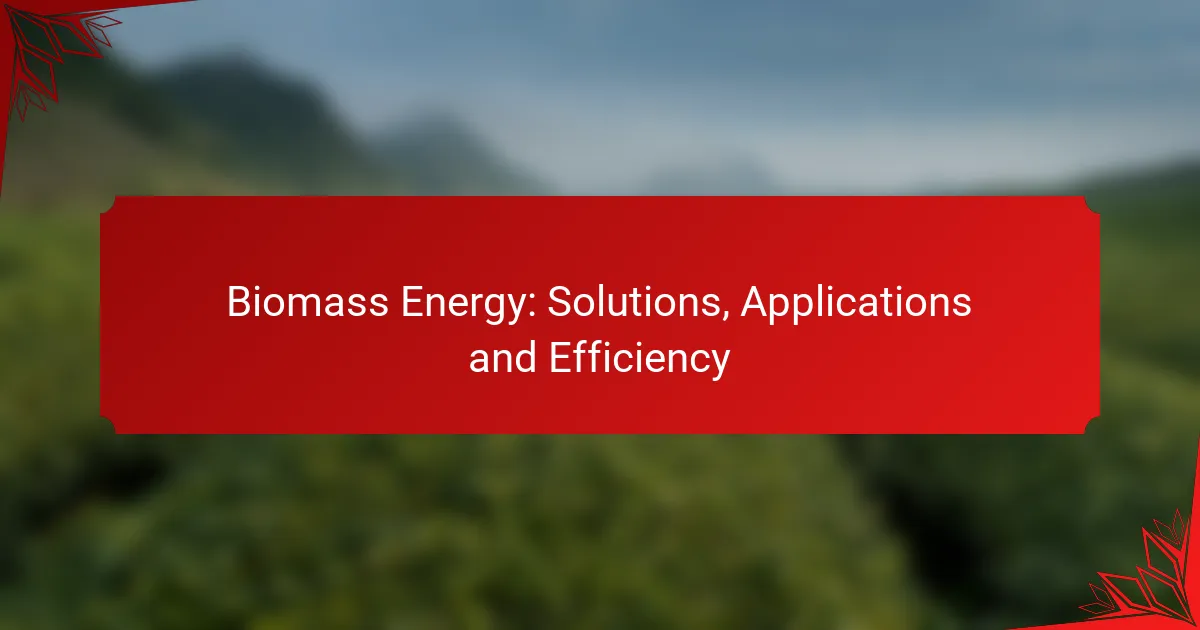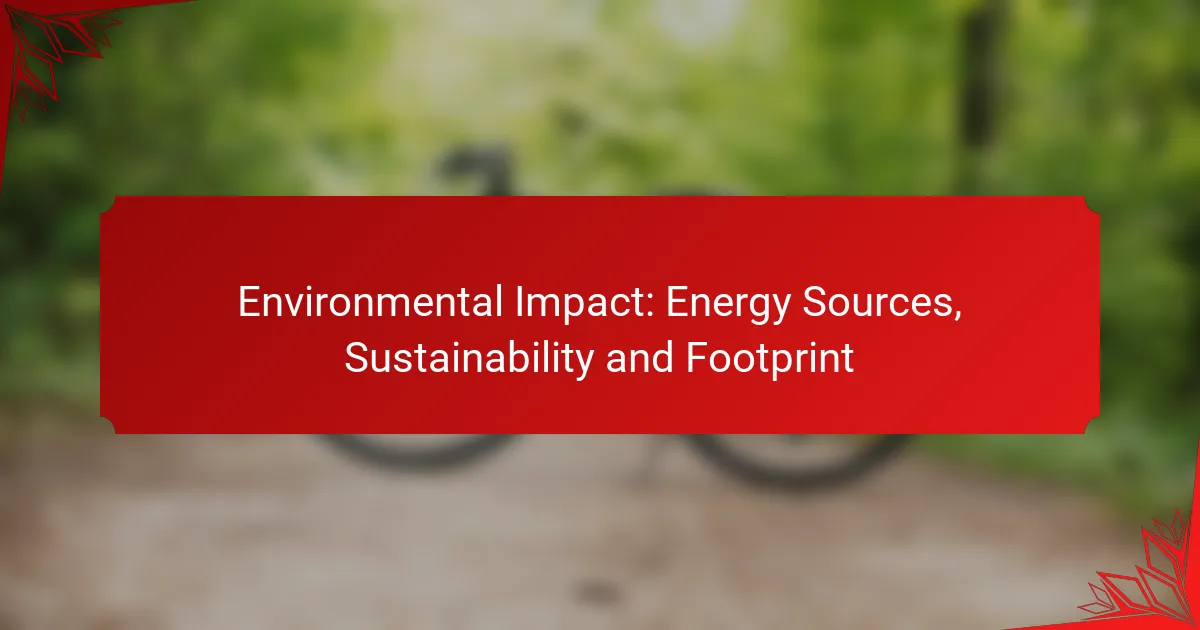Biomass energy represents a versatile solution for converting organic materials into usable energy forms, including heat, electricity, and fuels. With conversion efficiencies ranging from 20% to 90%, its effectiveness varies based on biomass type and technology used. This renewable energy source finds applications across residential, industrial, and transportation sectors, promoting sustainability and reducing dependence on fossil fuels.

What are the biomass energy solutions available?
Biomass energy solutions include various methods of converting organic materials into usable energy forms. These solutions leverage different feedstocks and technologies to produce heat, electricity, and fuels, contributing to renewable energy goals.
Biogas production
Biogas production involves the anaerobic digestion of organic materials, such as agricultural waste, manure, and food scraps, to generate methane-rich gas. This gas can be used for heating, electricity generation, or as a vehicle fuel.
Key considerations include the type of feedstock, the scale of the digester, and local regulations regarding waste management. Biogas systems can vary from small-scale digesters for farms to large facilities that process municipal waste.
Wood pellet heating
Wood pellet heating utilizes compressed wood pellets as a renewable energy source for residential and commercial heating. These pellets are made from sawdust and wood shavings, providing a cleaner alternative to traditional wood burning.
When considering wood pellet heating, evaluate the availability of pellets, the efficiency of the heating system, and the upfront costs versus long-term savings. Systems can be integrated with existing heating infrastructures, making them versatile options.
Biofuel generation
Biofuel generation converts biomass into liquid fuels, such as biodiesel and ethanol, through processes like fermentation and transesterification. These biofuels can replace fossil fuels in transportation and industrial applications.
Common feedstocks for biofuels include vegetable oils, animal fats, and sugarcane. It’s essential to consider the sustainability of the feedstock and the lifecycle emissions when evaluating biofuel options.
Waste-to-energy systems
Waste-to-energy systems convert municipal solid waste into energy through combustion or gasification. This process reduces landfill waste while generating electricity and heat, contributing to energy recovery efforts.
When implementing waste-to-energy solutions, assess the technology’s efficiency, emissions control measures, and local waste management policies. These systems can significantly reduce waste volume while providing a renewable energy source.
Algae-based energy
Algae-based energy harnesses the rapid growth of algae to produce biofuels, biogas, and other valuable products. Algae can be cultivated in various environments, including freshwater and saltwater, making them a versatile feedstock.
Consider the cultivation method, processing technology, and potential market for algae products when exploring this solution. Algae can produce higher yields per acre compared to traditional crops, making them an attractive option for sustainable energy production.

How efficient is biomass energy?
Biomass energy efficiency varies widely based on the type of biomass, conversion technology, and end-use applications. Generally, biomass can achieve conversion efficiencies ranging from 20% to 90%, depending on the method used for energy extraction.
Conversion efficiency rates
Conversion efficiency rates for biomass energy refer to the percentage of energy extracted from biomass compared to the total energy content available. For instance, direct combustion of biomass typically yields lower efficiencies, around 20% to 30%, while advanced technologies like gasification or anaerobic digestion can reach efficiencies of 60% to 90%.
Factors influencing these rates include the moisture content of the biomass, the technology employed, and the specific application. For example, wood pellets used in high-efficiency stoves can significantly outperform raw wood logs in terms of energy output.
Lifecycle emissions analysis
Lifecycle emissions analysis evaluates the total greenhouse gas emissions produced from biomass energy, including cultivation, processing, transportation, and combustion phases. While biomass is often considered carbon-neutral, this assessment can reveal significant emissions depending on land-use changes and agricultural practices.
For example, using agricultural residues may have lower emissions compared to dedicated energy crops, which can require fertilizers and land conversion. It’s essential to consider these factors when assessing the overall sustainability and efficiency of biomass energy solutions.

What are the applications of biomass energy?
Biomass energy has diverse applications across various sectors, including residential heating, industrial power generation, and transportation fuels. These applications leverage organic materials to produce energy, contributing to sustainability and reducing reliance on fossil fuels.
Residential heating
Biomass energy is widely used for residential heating through systems that burn wood pellets, chips, or logs. These systems can be more cost-effective than traditional heating methods, especially in rural areas where biomass resources are readily available.
Homeowners should consider the efficiency of their biomass heating system, which can vary significantly. Modern pellet stoves can achieve efficiencies of over 80%, while older models may be less efficient, leading to higher fuel costs.
Industrial power generation
In industrial settings, biomass energy is utilized to generate electricity and heat. Facilities often convert biomass into biogas through anaerobic digestion or burn it directly in boilers to produce steam for power generation.
Industries can benefit from using biomass as a renewable energy source, potentially lowering their carbon footprint and energy costs. However, they must ensure compliance with local regulations regarding emissions and waste management.
Transportation fuels
Biomass can be converted into biofuels, such as biodiesel and ethanol, which serve as alternatives to conventional fossil fuels in transportation. These fuels can help reduce greenhouse gas emissions and dependence on oil.
When considering biomass for transportation fuels, it’s essential to evaluate the feedstock source and production methods. Sustainable practices, such as using waste materials, can enhance the environmental benefits of biofuels while minimizing competition with food production.

What are the benefits of biomass energy?
Biomass energy offers several advantages, including its renewability, potential for waste reduction, and ability to contribute to carbon neutrality. These benefits make it an attractive alternative energy source in various applications.
Renewable resource
Biomass is considered a renewable resource because it is derived from organic materials such as plants, agricultural residues, and animal waste. As long as biomass is managed sustainably, it can be replenished naturally, making it a viable long-term energy source.
For instance, energy crops like switchgrass or miscanthus can be grown specifically for biomass production, ensuring a continuous supply. This contrasts with fossil fuels, which are finite and deplete over time.
Waste reduction
Utilizing biomass energy helps in reducing waste by converting organic materials that would otherwise end up in landfills into usable energy. This process not only minimizes landfill use but also decreases methane emissions, a potent greenhouse gas produced during decomposition.
Common waste sources include agricultural byproducts, food waste, and forestry residues. By converting these materials into energy, communities can address waste management challenges while generating power.
Carbon neutrality potential
Biomass energy has the potential to be carbon neutral, as the carbon dioxide released during combustion is roughly equivalent to the amount absorbed by the plants during their growth. This cycle can significantly reduce overall greenhouse gas emissions compared to fossil fuels.
However, achieving true carbon neutrality depends on sustainable biomass sourcing and management practices. It is essential to consider the entire lifecycle of biomass production, including land use and transportation emissions, to evaluate its environmental impact accurately.

What are the challenges of biomass energy?
Biomass energy faces several significant challenges that can impact its efficiency and viability as a renewable energy source. These include competition for land use, complex supply chain logistics, and various technological barriers that need to be addressed for optimal implementation.
Land use competition
Land use competition arises when biomass production competes with food crops and natural ecosystems for arable land. This can lead to increased food prices and potential food shortages, particularly in regions where agricultural land is limited. Balancing biomass cultivation with food production is crucial to ensure sustainable land management.
In many areas, especially in developing countries, the demand for agricultural land can overshadow biomass initiatives. Policymakers must consider zoning regulations and land-use planning to mitigate conflicts and promote sustainable practices.
Supply chain logistics
Supply chain logistics for biomass energy can be complex and costly due to the need for efficient collection, transportation, and processing of raw materials. Biomass feedstocks are often bulky and low in energy density, making transportation challenging and expensive. This can limit the economic feasibility of biomass projects, especially in remote areas.
To improve logistics, stakeholders should explore local sourcing strategies and invest in infrastructure that facilitates the collection and distribution of biomass. Implementing regional processing facilities can also reduce transportation costs and enhance supply chain efficiency.
Technological barriers
Technological barriers in biomass energy include the need for advanced conversion technologies that can efficiently transform biomass into usable energy. Current methods, such as combustion and gasification, may not always achieve optimal efficiency or emissions standards, which can hinder widespread adoption.
Investing in research and development of innovative technologies is essential to overcome these barriers. Collaboration between governments, academia, and industry can accelerate the development of more efficient biomass conversion processes, making biomass a more viable energy option.

How to choose biomass energy solutions?
Choosing biomass energy solutions involves evaluating factors such as resource availability, technology options, and economic feasibility. Key considerations include the type of biomass feedstock, conversion technology, and the specific energy needs of your application.
Cost analysis
Cost analysis for biomass energy solutions requires a comprehensive assessment of both initial investments and ongoing operational expenses. Factors such as feedstock procurement, equipment costs, and maintenance should be included in the analysis.
For example, small-scale biomass systems may range from a few thousand to tens of thousands of USD, depending on the technology and scale. In contrast, larger installations can exceed hundreds of thousands of USD. It’s essential to compare these costs against potential savings and revenue from energy production.
Additionally, consider local incentives and subsidies that may reduce upfront costs. Many regions offer financial support for renewable energy projects, which can significantly impact the overall cost-effectiveness of biomass energy solutions.



